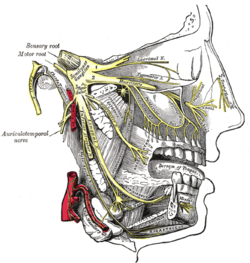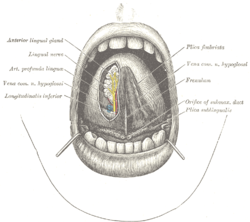Lingual nerves
| Lingual nerve | |
|---|---|

Distribution of the maxillary and mandibular nerves, and the submaxillary ganglion.
|
|

The mouth cavity. The apex of the tongue is turned upward, and on the right side a superficial dissection of its under surface has been made.
|
|
| Details | |
| From | mandibular nerve |
| Innervates | tongue |
| Identifiers | |
| Latin | nervus lingualis |
| MeSH | A08.800.800.120.760.500.450 |
| Dorlands /Elsevier |
n_05/12566098 |
| TA | A14.2.01.081 |
| FMA | 53218 |
|
Anatomical terms of neuroanatomy
[]
|
|
The lingual nerve is a branch of the mandibular division of the trigeminal nerve (CN V3), which supplies sensory innervation to the tongue. It also carries fibers from the facial nerve, which return taste information from the anterior two thirds of the tongue, via the chorda tympani.
The lingual nerve lies at first beneath the lateral pterygoid muscle, medial to and in front of the inferior alveolar nerve, and is occasionally joined to this nerve by a branch which may cross the internal maxillary artery.
The chorda tympani (a branch of the facial nerve, CN VII) joins it at an acute angle here, carrying taste fibers from the anterior two thirds of the tongue and parasympathetic fibers to the submandibular ganglion.
The nerve then passes between the medial pterygoid muscle and the ramus of the mandible, and crosses obliquely to the side of the tongue beneath the constrictor pharyngis superior and styloglossus, and then between the hyoglossus and deep part of the submandibular gland; it finally runs from laterally to medially inferiorly crossing the duct of the submandibular gland, and along the tongue to its tip becoming the sublingual nerve, lying immediately beneath the mucous membrane.
A well known rhyme has been used by anatomy students for many years to remember some features of the lingual nerve anatomy mentioned above: "The Lingual Nerve, Describes a Curve, Across the Hyoglossus...
The lingual nerve supplies general somatic afferent innervation from the mucous membrane of the anterior two-thirds of the tongue, while the posterior one-third is innervated by the glossopharyngeal. It also carries nerve fibers that are not part of the trigeminal nerve, including the chorda tympani nerve of the facial nerve, which provides special sensation (taste) to the anterior 2/3 part of the tongue as well as parasympathetic and sympathetic fibers.
...
Wikipedia
